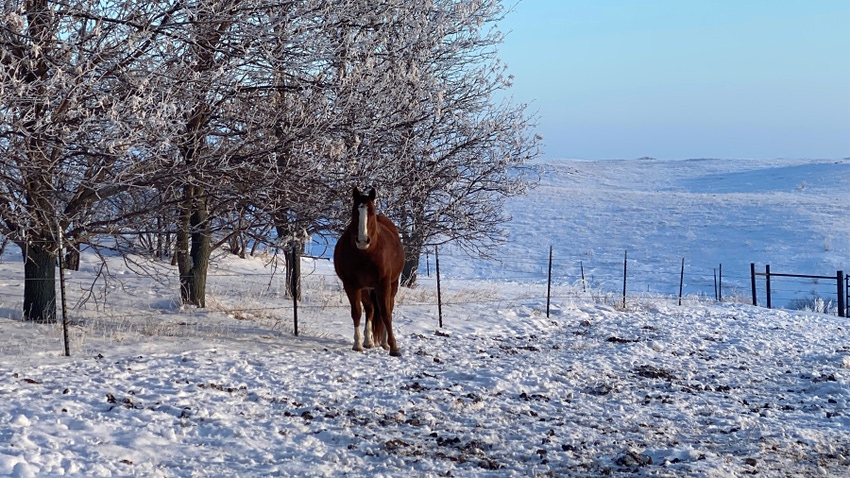
While no one is immune to the icy winds of a Great Plains winter, horse owners can do a few things to ensure their equine partner gets through the winter weather. Evaluating structure and environment, calculating food intake, and even throwing on a blanket can all keep horses more comfortable.
1. Keep snow and ice at bay. Icy or slippery pens can easily cause slips and falls that can lead to injury. While the best option is to keep horses in other pens until the ice melts, this isn’t always possible. University of Minnesota Extension says sand and salt can help manage ice. Sand will increase traction, while salt can speed melting, depending on the temperature.
When using these methods, spread sand away from where you pitch or feed horses to avoid accidental ingestion. Choose only one method to manage pens, as a mixture of salt and sand may lead to sand ingestion via the salt.
During times of heavy snowfall, remove snow from pens to allow horses to eat and drink. Avoid creating snow piles in low areas and drainage ways, or near drinking sources. Proper snow removal in the winter will lead to an easy spring thaw.
2. Supply enough feed. If feeding hay to horses, supply a sufficient amount to help keep them warm. North Dakota State University Extension says to assume 20% waste when feeding hay. A rule of thumb is to feed an amount equal to 2% of body weight for a non-lactating animal. An average 1,000-pound horse would require 24 pounds of hay each day. That accounts for at least 4 pounds of waste. If you use a bale feeder or other feeder equipment, you can likely lower that waste level to below 20%.
Getting the quantity right is important if access to winter pasture is not an option. But cold temperatures can change the daily feed requirement. For each 10 degrees below 30 degrees F, horses will need an additional intake of about 2 pounds of feed per day. If you add 10- to 15-mph winds into the equation, NDSU says to add 4 to 8 pounds to the daily intake. If the horse does not have access to shelter and is exposed to wet, windy conditions, that daily intake may rise by an extra 10 to 14 pounds of hay.
3. Go high with fiber. High-fiber feeds, like high-quality hay, produce more heat during digestion than low-fiber feeds such as corn, barley or other grains. While a low-fiber grain, oats produce more heat for a horse because its outer hull is fibrous, according to NDSU.
4. Shield from wind. Horses that are kept outside exclusively should be given some sort of free-choice shelter to protect themselves from the environment. A three-sided, open front shed or shelter is most common in the Midwest. If adding one of these sheds to your pens, plan for 150 square feet of roofed area per horse.
With no wind or moisture, horses can tolerate temperatures slightly below zero. But if horses have access to a shelter, they can tolerate temperatures as low as −40 degrees. Research by U-M found 62% of horses seek shelter when winds are greater than 11 mph, while mild conditions with wind under 10 mph found horses outside of shelters.
5. Toss on a blanket. Horses’ coats get fluffy as their winter coat grows in. Horses continue to develop their built-in coat until the winter solstice, or late December. Horse coats insulate the animal by trapping and warming air around the body, and a blanket is not usually needed for horses given proper shelter.
However, U-M finds a blanket should be given if:
No shelter is available.
The animal is young or old.
The horse is thin.
A rain, snow or ice storm is expected.
When covering a horse with a blanket, make sure it fits properly to avoid rubbing the animal and creating sores. Ensure the blanket stays dry underneath, and never blanket a wet animal. Instead, allow both the horse and the blanket to dry fully before putting the blanket on.
While horse owners can do nothing to regulate low winter temperatures, taking these steps can help their animals weather the season unscathed.
Read more about:
HorsesAbout the Author(s)
You May Also Like








